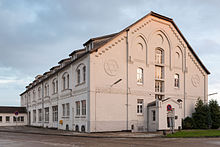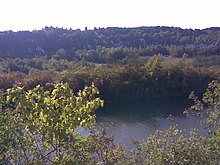Cement industry near Hanover

Illustrierte Zeitung no. 3538 , special title Hannover and border areas , of 20 April 1911 with the artist's signature graphic artist Änne Koken
The cement industry near Hanover is the focus and the center of production for the building material cement in Lower Saxony . The cement industry is operated in Misburg , a current district of Hanover, and in Höver , a district of Sehnde . There and in the neighboring towns a large number of cement works and marl pits have been built since 1873 , which shape the landscape.
history
Emergence
The basis for the formation of the cement industry near Hanover was clayey limestone , which in this area is very thick and right up to the surface of the earth. In addition, the material from the Upper Cretaceous period is easy to grind. The entrepreneurs Friedrich Kuhlemann and Albert Meyerstein laid the foundation stone for cement production when they acquired a lime distillery in Misburg in 1873 . The facility was located north of the existing Hanover-Lehrte freight railway and could be connected to the rail network via its own siding. Good transport connections were extremely important for the transport of the heavy bulk cement. After the distillery was shut down, they began building the Hanoverian Portland Cement Factory (HPC) on this site in 1877 . In the following year, they hired the Szczecin cement expert Hermann Manske as operations manager and began with the horse brand with the cement production of initially 5,000 tons per year.
In 1881 Manske left the Misburg HPC factory and founded the Germania cement factory with three limited partners in Lehrte . With other limited partners, Manske began building the Misburger Germania factory south of the freight railway in 1886 , but in the immediate vicinity of the HPC.
The Portland cement factory Kronsberg was built independently of Manske in 1889 . In 1897, the former operations manager of the Misburg Germania plant, Berthold Lange, established the Teutonia Misburg Portland cement plant in the immediate vicinity of the Germania plant. The North German Portland cement factory in Misburg followed in 1898 . An elongated factory hall, which was later used as a factory canteen, has been preserved from 1899. The brick building at Lohweg 32 is structured by nine axes. The central axis is emphasized by the stairwell windows and the protruding entrance. Blind arches and star ornaments adorn the facade facing the street. The building is a listed building.
Hermann Manske began building his third cement plant in 1899 at what would later be the Anderter Bahnhof, which was completed in 1901.
By the end of the 19th century, seven cement plants had been built near Misburg. The cement produced was mainly used in Hanover and the surrounding area. At that time, cement was a sought-after building material, as concrete quickly established itself in bridge and building construction. The consumption multiplied during this time.
20th century
In 1906, Manske founded the limited partnership Portland-Cementfabrik Alemannia H.Manske & Co with headquarters in the Villa Nordstern in Ilten , which today belongs to Lehrte after a 2006 border change agreement . This company built the Alemannia cement factory in Höver from 1907 to 1908 . In 1908 the plant was connected to the Hanover tramway . Most of the factories in Misburg and Anderten also had a tram connection.
As part of a capacity reduction, the Germania plant in Lehrte was shut down in 1910.
From 1935 to 1937 the Alemannia plant was fundamentally expanded. In addition to a raw mill, a coal mill and a Leopoldi furnace, a KdF bathing establishment was opened at the plant.
In 1943 the Kronsberg plant was shut down. During the Second World War, the remaining plants were bombed in the air raids on Hanover due to their proximity to the Deurag-Nerag refinery, which was important for the war effort . To report Germania 4,439,000 Reichsmark , Teutonia 2,404,000 RM and HPC 6,727,000 RM damage. The more distant Alemannia plant in Höver showed only RM 230,000 damage.
While the Alemannia plant resumed operations in 1945 after the Second World War , Teutonia could not go back into production until 1948, Germania 1950 and HPC 1951.
The construction boom in the post-war period brought the companies full order books. The largely covered housing demand was responsible for a decline in demand from the mid-1970s, as was the emergence of other building materials such as wood, steel or glass. In 1976 the Germania plant in Misburg was the victim of efforts to concentrate, was shut down and later demolished. In 1988 clinker production was stopped at HPC. Teutonia continued to operate the grinding plant for its production until 2011 , and a railway sleeper plant was also built on the site.
Present and Future
Teutonia in Misburg
The HPC and Teutonia plants in Misburg are now part of HeidelbergCement AG. The marl pits HPC I and HPC II have been exploited and will be transferred to subsequent use. For this purpose, Teutonia AG and the state capital Hanover have founded a joint company. The footbridge over the Misburg branch canal connecting the two pits has already been repaired and released for general use.
Since rare species have already settled in pit HPC I south of the branch canal, this should be made accessible to the public as largely unchanged as possible. In order not to flood the pit, the dewatering from the mining operation is not turned off.
The HPC II pit north of the branch sewer is filled with unpolluted soil. When this process is completed around 2022, a swimming lake will be created there.
Alemannia in Höver
The Alemannia plant in Höver is part of the Holcim Group. Höver is characterized by the cement industry by the processing plants with their high silo towers and the deep pits around the place for mining the light marl. There are even transport routes for material through the town center. The immediate location on the Mittelland Canal facilitates the delivery of the slag sand from Salzgitter and the removal of the cement produced.
In 2008 the plant celebrated its centenary. Holcim does not continue to use the name Alemannia , the official name today is the Höver plant .
Photo gallery
Bucket wheel excavator in the marl pit of the Teutonia cement works in Hanover-Misburg
literature
- Waldemar R. Röhrbein : Hannoversche Portland-Zementfabrik in: Stadtlexikon Hannover , p. 261
- Gerd Meier, Dissertation: Origin, development and structural change of the Portland cement industry in the Hanover area from 1878 to 1989 (PDF; 60.9 MB) , University of Hanover (Faculty of Humanities and Social Sciences), 2001
Web links
- Website of HeidelbergCement AG, Hanover plant
- Website of Holcim AG, Höver plant
- Leaflet of the state capital Hanover on the natural design of the marl pit HPC I (pdf)
- mineralienatlas.de: Misburg, North Pit
- mineralienatlas.de: Misburg, South Pit
- mineralienatlas.de: Höver
- Gisbert Selke: Misburg-Anderten - center of the Lower Saxony cement industry
- Description of the geology and fossils in the marl quarry of Holcim with photos and a map by the State Office for Mining, Energy and Geology in Lower Saxony, (pdf)
- Description of the fossils in the limestone marl pit Teutonia with photos and map by the State Office for Mining, Energy and Geology in Lower Saxony (PDF)
Individual evidence
- ↑ Wolfgang Neß, Ilse Rüttgerodt-Riechmann, Gerd Weiß (ed.): Architectural monuments in Lower Saxony. 10.2. City of Hanover, part 2. Friedrich Vieweg and son, Braunschweig / Wiesbaden, 1985. ISBN 3-528-06208-8 . P. 180.
Coordinates: 52 ° 22 ′ 29 ″ N , 9 ° 52 ′ 30 ″ E













